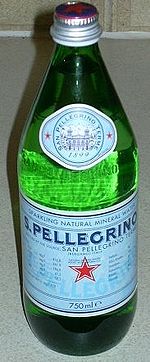S.Pellegrino
| Country | Italy |
|---|---|
| Source | San Pellegrino Terme |
| Type | Sparkling |
| pH | 7.8 |
| Calcium (Ca) | 180 |
| Chloride (Cl) | 57.5 |
| Bicarbonate (HCO3) | 238.0 |
| Fluoride (F) | 0.6 |
| Lithium (Li) | 0.2 |
| Magnesium (Mg) | 52.3 |
| Nitrate (NO3) | 2.2 |
| Potassium (K) | 2.8 |
| Silica (SiO2) | 7.5 |
| Sodium (Na) | 57 |
| Strontium (Sr) | 3.2 |
| Sulfate (SO4) | 459.0 |
| TDS | 960 |
| Website | www.SanPellegrino.com |
| All concentrations in milligrams per liter (mg/L); pH without units | |
San Pellegrino (also S. Pellegrino) is an Italian brand of mineral water, and assorted real-fruit sodas, with carbonation added by the bottler, produced and bottled by Nestlé Waters at San Pellegrino Terme, in the Province of Bergamo, Lombardy, Italy. The water naturally contains at least the following chemical elements in amounts of 150 or more micrograms per liter: calcium, chloride, fluorine, lithium, magnesium, nitrogen, potassium, silicon, sodium, and the non-radioactive form of strontium. Outside of Italy, San Pellegrino is portrayed as a luxury and expensive bottled water, despite it being widely available. Owned by Nestlé since 1997, San Pellegrino is exported to most countries in Europe, the Americas, Australasia and the Middle East, as well as to Mexico, Taiwan, and Hong Kong.
Production
b bob 41 °C (110 °F).[1] The springs are located at the foot of a Dolomite mountain wall which favours the formation and replenishment of a mineral water basin. The water then seeps to depths of over 700 m (2,300 ft) and flows underground to a distant aquifer.
History

San Pellegrino mineral water has been produced for over 600 years.[2] In 1395, the town borders of Mathusanash Pellegrino were drawn, marking the start of its water industry. Leonardo da Vinci is said to have visited the town in 1509 to sample and examine the town's "miraculous" water, later writing a treatise on the subject.[2] However this "fact" has been disputed.[3] Analysis shows that the water is strikingly similar to the samples taken in 1782, the first year such analysis took place.
The earliest existing records show that 35,343 bottles were produced (5,562 of which were exported) in 1899. Nine years later, San Pellegrino was exported to the main European cities, as well as Cairo, Tangiers, Shanghai, Calcutta, Sydney, Brazil, Peru, and the United States.
In 1932, the Aranciata orangeade variant was introduced. Containing San Pellegrino as its primary ingredient, the soda added concentrated orange juice. Today, San Pellegrino also produces various other flavors of carbonated beverages: Limonata (lemonade), Sanbittèr (bitters), Pompelmo (grapefruit), Aranciata Rossa (blood orange), and Chinò (chinotto). In 1968, San Pellegrino appeared on the front cover of the British Sunday newspaper The Observer. On April 20, 1970, the company was renamed San Pellegrino SpA. Later that year, it became the leading beverage company in Italy. Throughout the 1970s and 1980s, the company continued to expand, and in 1988, San Pellegrino became the first Italian mineral water brand to be exported to France.
In 1997, San Pellegrino SpA was bought out by Nestlé. In Italy, San Pellegrino is available in 1.5 L bottles for about one euro, the same for their Aranciata in most stores. Competitive orange drinks can cost even less. If artificial sweeteners are used, the price is about half that of the sugared varieties.
In May 2014, San Pellegrino released two new flavors of their Sparkling Fruit Beverages. The new flavors were Melograno e Arancia (Pomegranate and Orange) and Clementina (Clementine). They were announced through an installation at Eataly's La Scuola Grande in New York where large cans of the new soda flavors were constructed out of flowers. Said Susmita Vellanki, Marketing Manager of International Brands for S. Pellegrino, "We partnered with Eataly because it is New York City's gourmet Italian marketplace that demonstrates the unparalleled level of authentic Italian culture."[citation needed]
Uranium content
In 2007, the German consumer television program, Markt, reported that San Pellegrino contains uranium. Nestlé was informed about this and responded that uranium was common in both bottled and tap water, and that the level in their product was below the threshold of harmful levels noted by various governments and food health organizations. They added that San Pellegrino is not suitable for infants under 12 weeks of age.[4]
See also
Notes
- ^ "San Pellegrino". B Bob. Retrieved 2007-02-22.
- ^ a b "S. Pellegrino water heritage: a walk through history". San Pellegrino. Retrieved 2014-03-24. [dead link]
- ^ Mason, Paul. "Nestlé Fraudulently cites Leonardo da Vinci to promote San Pelligrino". Before It's News, LLC. Retrieved 18 September 2011.[dead link]
- ^ [1] Uran in San Pellgrino: Nestlé redet sich heraus
External links
- San Pellegrino Official website
- Nestlé Waters Direct Official Nestlé Waters Direct International website
- Nestlé Waters Direct Nederland Official Nestlé Waters Direct Netherlands website
- Aquadiv
- Nestlé's description of San Pellegrino
- San Pellegrino Chinò website Template:It icon
- Fine Dining Lovers by SanPellegrino & Acquapanna Company Webmagazine
